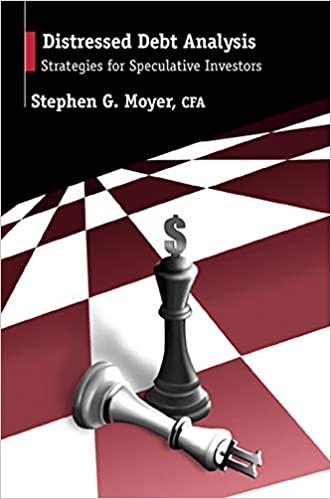Question
You are the finance officer of a large Municipality in your country and you are investing in cattle futures. You purchase futures contracts worth 400,000
You are the finance officer of a large Municipality in your country and you are investing in cattle futures. You purchase futures contracts worth 400,000 pounds of cattle with an exercise price of $0.60 per pound and an expiration date in one month.
i) Show the economics of a futures transaction if the price of cattle at delivery date is $0.40 per pound, $0.60 per pound, or $0.80 per pound.
ii) Is this a risk-reducing transaction? iii) Would your answer to (b) be different if the treasurer were investing in oil futures? What about interest rate futures? 2 Marks Each
ci) Show how one can replicate a one-year pure discount bond with a face value of $100 using a share of stock, a put and a call.
ii) Suppose that S = $100, P = $10, and C = $15. What must be the one-year interest rate? iii) Show that if the one year risk-free interest rate is lower than your answer to part
(ii), there would be an arbitrage opportunity. 2 Marks Each
3a) Suppose that soft cola, a multinational soft-drinks company is thinking about opening a plant in a developing country. The exchange rate in that country is pegged to the dollar but due to economic and political problems in that country, there are restrictions on the convertibility and repatriation of profits to the United States. Also, the level of these restrictions is liable to change with the whims of those in power. The CEO of soft cola calls you a financial economist to evaluate the risks involved in such a venture.
i) Would soft cola face exchange-rate risks if it decided to open a plant in this developing country? What risk would it face and how could it avoid this risk? 5 Marks
ii) If the CEO decides to go ahead and open a plant in the developing country, what in effect has been soft colas risk management strategy? 5 Marks
b) You have been hired in the risk management division in a multinational beverage company, and have recently been put in charge of managing the franc / dollar exchange-rate risks that the company faces. Consider the companys operations in France and the United States.
i) Suppose monthly revenues in France average Ffr. 100 million and monthly production and distribution costs average Ffr. 80 million. If the resulting profits are repatriated to the production unit in the United States monthly, what risk does this production unit face? How might it hedge this risk? 3 Marks
ii) The companys worldwide retirement benefits unit is located in the United States and has an obligation to pay its retired French employees Ffr 20 million monthly. What risk does this unit face and how could it hedge the risk? 3 Marks
iii) Given the transactions of the production and retirement units as given previously, what do you conclude are the exchange-rate risks faced by the company as a whole in France? Does the company need to enter into forward contracts? 4 Marks
4) Answer briefly the following questions:
a) What are discount points, and why do some mortgage borrowers choose to pay them?
b) Differentiate between conventional mortgage loans and insured loans.
c) Write briefly on securitized mortgage.
d) When the Euro appreciates, are you more likely to drink California or French wine? Explain
e) A country is always worse off when its currency is weak. Is this statement true, false or uncertain? Explain your answer.
f) If there is a strike in Germany, making it harder to buy German goods, what will happen to the value of the Euro?
g) If the president of your country announces that he will reduce inflation with a new antiinflation program. If the public believes him, predict what will happen to the exchange rate for your countrys currency? h) Why has the development of overnight loan markets made it more likely that banks will hold fewer excess reserves?
i) Bank managers should always seek the highest return possible on their assets. Is this statement true, false or uncertain? Explain your answer.
j) Banking has become a more dynamic industry because of more active liability management. Is this statement true, false or uncertain? Explain your answer. 20 Marks
5a) Suppose the spot rate on four-year bond is 7 percent and the spot rate on five-year bond is 8 percent. What forward rate is implied on a one-year bond delivered four years from now? 3 Marks
b) Define price risk and reinvestment risk. Explain how the two risks offset each other. 2 Marks
c) An investor pays $96,000 for a 180-day T-bill with $100,000 face value. What is the yield on the T-bill? 2 Marks
d) Define money market and discuss its main role. 3 Marks
e) It is the end of 2013, and a $1 dividend is just about to be paid by Macrown limited. In future, the board expected to pay a once-a-year dividend of $3, $5, and $7 at the end of 2014, 2015, and 2016 respectively, after which they expect the dividend will grow by a constant 5% p.a. If the rate of return required on Macrown limited shares is k = 14% p.a. What do you estimate using the dividend growth model should be the current cum-div price of their shares? 4Marks
f) Describe five comparative differences between ordinary shares and preference shares. 3 Marks
g) List five comparative difference between the futures and forward markets. 3 Marks
Step by Step Solution
There are 3 Steps involved in it
Step: 1

Get Instant Access to Expert-Tailored Solutions
See step-by-step solutions with expert insights and AI powered tools for academic success
Step: 2

Step: 3

Ace Your Homework with AI
Get the answers you need in no time with our AI-driven, step-by-step assistance
Get Started


